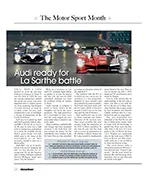
Audi ready for La Sarthe battle
You’ll need a long memory to recall the last time Audi got it wrong at Le Mans. It was way back in 1999, the year the German manufacturer entered the…
TUNING MOTOR CYCLES FOR SPEED.
Some Practical Hints for Amateur Competition Riders. (Note : The illustrations for this article were specially taken in the Motor Cycle Repair Depot of Maudes’ Motor Mart.)
N endeavouring to offer any useful suggestions on the above-mentioned subject, the writer realises that machines used for competition vary so much in type and condition as to place difficulties in the way of indicating how the best results may be obtained to suit individual cases, though perhaps the subject may be treated usefully by dealing with the procedure on general lines.
To begin with, we may assume the machine about to be treated is fitted with an overhead valve engine and has at least some pretensions at being classed as a Sports Model. Competitions of to-day are so keenly contested that only good riders mounted on first class machines have any hopes of success, but at the same time, should any modest reader be doubtful as to his qualifications as a competition rider, he may be assured that common sense is a good substitute for at least a part of an apprenticeship and also for a large amount of book learning.
Whether one proposes to use a brand new machine, or a second-hand model overhauled in readiness for its new owner, no serious attempt at tuning is recommended until the machine has completed its first thousand miles and has become thoroughly run in. Even in the case of an overhauled machine, the engine cannot be expected to give the best results until the parts have had a chance of bedding themselves together again and during this operation, more than the ordinary amount of care must be paid to the matter of lubrication.
Removal of Superfluous Fittings. One of the first things to occupy the attention of the intending competition rider is the removal of all superfluous accessories, which besides adding to the dead weight only tend to interfere with the accessibility of the mechanism. As far as the lighting is concerned, there is much to be said in favour of using a good selfcontained acetylene lamp, which can be removed when
desired by undoing a couple of nuts. When it comes to the point of making timed checks for speed, a stop watch will prove invaluable and the machine must be fitted with a reliable speedometer, the popular Bonniksen being hard to beat for accuracy and general utility. If the rider is mathematically inclined he will be able to turn to account the characteristic action of this instrument, whereby two speed registering hands work alternatively at five second intervals. From this one is able to gather much useful information concerning acceleration and braking effect, for modern tuning is largely a matter of scientific investigation and must he treated as such.
Attention to Frame and Wheels.
When about to undertake tuning operations, most riders begin by directing their undivided attentions to the engine, which is quite reasonable and proper provided the frame and wheels receive an equal amount of care. What usually happens, however, is that the enthusiastic amateur is so keen on trying out the improved engine as to overlook or hurry over the needful attention to the other parts of the machine. For the latter reason it is proposed to deal with the less interesting, but highly important, section of motor cycle tuning first, reserving our remarks upon engine efficiency for a subsequent occasion.
Frame Alignment and Steering.
From casual observations on the road one would imagine the average motor cyclist to be an extremely careless individual where frame alignment is concerned, but those who are quite ready to risk unnecessary skids and irregular steering on the road, should be warned against the danger of imperfect frame alignment where high speeds on the track, or other speed courses, are contemplated. In cases where the rider means to do things thoroughly and dismantles the entire machine, there will be but